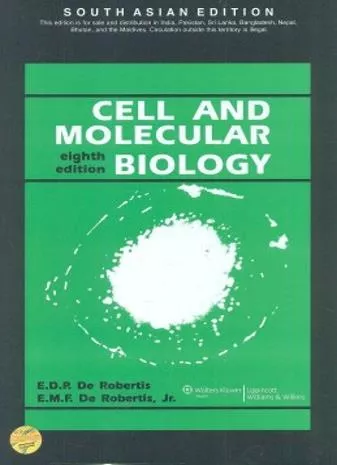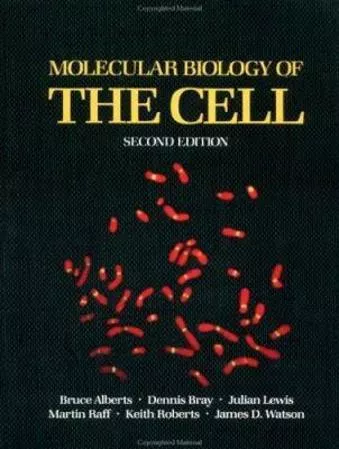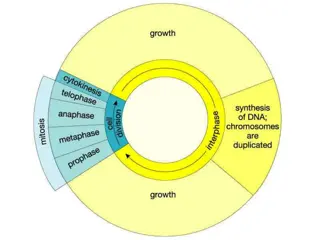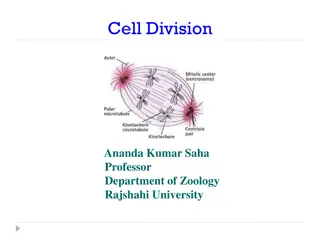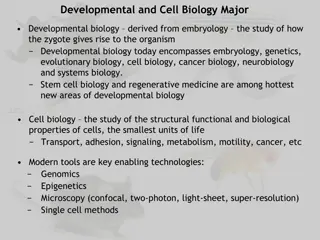Cell Organization and Evolutionary Perspectives
Prokaryotic and eukaryotic cells are the basic units of all living matter. This article explores the differences in organization between these two cell types, their characteristics, and evolutionary relationships. From discussing cellular structures to the presence of endomembranes, mitochondria, and chloroplasts, the text delves into various aspects defining prokaryotes and eukaryotes. Additionally, it highlights the evolutionary view that posits prokaryotes as ancestors of eukaryotes, supported by homologies in molecular organization and function. The content also touches on specific examples like Mycoplasma and their distinct characteristics compared to bacteria.
Download Presentation

Please find below an Image/Link to download the presentation.
The content on the website is provided AS IS for your information and personal use only. It may not be sold, licensed, or shared on other websites without obtaining consent from the author.If you encounter any issues during the download, it is possible that the publisher has removed the file from their server.
You are allowed to download the files provided on this website for personal or commercial use, subject to the condition that they are used lawfully. All files are the property of their respective owners.
The content on the website is provided AS IS for your information and personal use only. It may not be sold, licensed, or shared on other websites without obtaining consent from the author.
E N D
Presentation Transcript
Prokaryotic and Eukaryotic cells Organization Different types
What is a cell? A basic unit of organization or Structure of all living matter. A.G.Coewy and P. Sickevits (1963) Unit of Biological activity, delimited by a semipermeable membrane and capable of self reproduction in a medium free of other living systems . Wilson and Morris (1966) An integrated and continuously changing system . John Paul (1970) The simplest integrated organization in living systems, capable of independent survival . Body of all living organism (Bacteria, blue green algae, plants and animals) except viruses has cellular organization and contains one or more cells. The organisms may be unicellular or multicellular. Thus, cells are recognized as one of the two recognizable types Prokaryotes and Eukaryotes
Characters Prokaryotes Eukaryotes E.g. Bacteria, Blue green algae and mycoplasms E.g. Protozoa, other algae, metaphytes and metazoa Nuclear Envelope Absent Present DNA Naked Combined with Proteins Chromosomes Single Multiple Nucleolus Absent Present Division Amitosis Mitosis or meiosis Ribosomes 70s (50s+30s) 80s (60s+40s) Endomembranes Absent Present Mitochondria Respiratory and Photosynthetic enzymes Present Chloroplast Absent Present in Plant cells Cell wall Non cellulosic Cellulosic, only in plants Exocytosis and Endocytosis Absent Present Locomotion Single, Fibril, Flagellum Cilia and Flagella
Eukaryotic Cell Prokaryotic Cell
Evolutionary View Prokaryotes are considered to be ancestors of eukaryotes. Fossils 3 billion years old contained evidence of prokaryotes alone and eukaryotes probably appeared 1 million year ago. In spite of the differences between prokaryotes and eukaryotes, there are considerable homologies in their molecular organization and function. EG. All living organisms employ the same genetic code and a similar machinery for protein synthesis. Prokaryote: eg. Mycoplasma, Bacteria, Cyanobacteria or Blue green algae
Mycoplasm Smallest mass, an older name for Mycoplasma was Pleuro pneumonia-Like Organisms (PPLO) Infectious diseases in animals including humans Size: 0.25 - 0.1 m in diameter Unicellular, Free living, Saprophyte or Parasite Shape Spherical, bound by plasma membrane (75 A thick), Composed of protein and lipid. Easily cultured (Pleomorphic many forms) Spheroid, thin branching filaments, stellate and asteroid They differ from Bacteria in following respects: Do not contain cell wall and mesosoms (Like Viruses and animal cells)Resistance to antibiotics such as Penicillin Filterable through the bacterial filters Growth is inhibited by Tetracyclins and similar antibiotics that act on metabolic pathway.
Discovered by French Scientist: E. Nocord and E. R. Roux (1898) Pleural fluids of cattles suffering from plueropneumonia. Similar organisms were later isolated from other animals eg. Sheep, goats, dogs, rats, mice and human being and were named Pleuropneuminia like organism (PPLO) According to Shellar and Bianchi 1987 Between the Viruses and Bacteria According to Albert et. al., 1989 - Simplest Bacteria At one side of the cell occurs bleb (localized collection of fluid) of ill understood function. PPLO contain many enzymes required for DNA replication, transcription, translation Unlike Viruses they are free-living and do not require host cell for their replication., reproduce by binary fission & budding.
Mycoplasmas are the smallest free- living organisms and considered the simplest of bacteria. Owing to their extremely basic genomes, mycoplasmas in fact are parasites exploiting host cells to fulfill their energy requirements biosynthesis of their components. and The discovery of mycoplasmas date back to 1898. Initially, due to their unknown nature and relationships with other organisms, while being minute in size and not being qualified as bacteria they were considered viruses for years. However, many years later with further discovery mycoplasmas were confused with the L-forms, which are bacteria that have lost their cell walls either completely or partially. Nevertheless, in 1950s and 1960s this confusion came to end when first genomic analysis data through DNA hybridization were obtained. This analysis ruled out any relationship of mycoplasmas to the L-forms.
Currently, mycoplasmas are considered to have evolved from gram- positive, walled eubacteria by degenerative evolution, meaning their evolutionary history appears to include the loss of cell wall. Further, in 1960s and 1970s knowledge about ultrastructure, cell membrane, genome and metabolic pathways of mycoplasmas resulted in conclusion that they are smallest and simplest self- replicating organisms. The lack of cell wall convey some unique properties of mycoplasmas such as sensitivity to osmotic shock and detergents, resistance to penicillin, and formation of odd fried-egg shaped colonies. Sections of mycoplasmas reveal that their cells are essentially built of three organelles, such as: the cell membrane, ribosomes, and circular double stranded DNA tightly packed molecule. Their mode of replication is no different from that of prokaryotes dividing by binary fission.
However for binary fission to happen, cytoplasmic division must fully synchronize with genome replication and in mycoplasmas cytoplasmic division lags behind genome replication, which ultimately results in the formation of multinucleated filaments. For In vitro cultivation of mycoplasmas it has been discovered that they are difficult to cultivate. The reasons for these difficulties for species such as Mycoplasma genitalium and Mycoplasma pneumoniae is that they lack all the genes involved in amino acid synthesis, making them dependent on exogenous supply of amino acids. In order to get rid of these deficiencies mycoplasmas are grown on complex media, usually consisting of beef heart infusion, peptone, yeast extract, and serum with various supplements.
Mycoplasmas are known to consist of just plasma membrane which makes them good models for membrane studies. Due to this reason the availability of these membranes in pure state have enabled in their chemical, enzymatic and antigenic characterization. The membrane mostly consists of 60% to 70% of proteins and rest 20% to 30% of lipid. Dependence on exogenous supplies of fatty acids, and cholesterol serves as advantage to conduct further studies on these organisms. Mycoplasma infections are commonly found in people with Lyme Disease. Of the over 100 known species, more than a dozen are found in humans.
Many of them cause disease. Mycoplasmas don t have a cell wall or cell nucleus, act like parasites within or outside host cells, and can take on different shapes. This versatility allows them to hide from the immune system and affect it in many ways. Because of these features, they are hard to diagnose and treat. The most common species, Mycoplasma pneumoniae, typically causes respiratory infections like pneumonia, bronchitis, pharyngitis, and asthma. But it s a stealth pathogen that can also cause non-respiratory diseases affecting the nervous system, blood, joints, skin, heart, liver, and pancreas. The other pathogenic species most typically found in humans are: Mycloplasma fermentans, Mycoplasma genitalium, Mycoplasma hominis, Mycoplasma pirum, Mycoplasma salivarium, Ureaplasma urealyticum, Ureaplasma parvum
Arthritis, chronic nongonococcal urethritis, chronic pelvic inflammatory disease, other urogenital infections and diseases, infertility, AIDS/HIV Arthritis, Gulf War Syndrome, Fibromyalgia, Chronic Fatigue Syndrome, Lupus, AIDS/HIV, autoimmune diseases, ALS, psoriasis and Scleroderma, Crohn's and IBS, cancer, endocrine disorders, Multiple Sclerosis, diabetes Arthritis, TMJ disorders, Eye and ear disorders and infections, gingivitis, periodontal diseases including even cavities. Pelvic inflammatory disease, infertility, non- gonococcal urethritis, vaginitis, cervicitis, amnionitis, pyelonephritis, post-partum septicemia, neonatal pneumonia, neonatal conjunctivitis, Reiter's syndrome, peritonitis, wound infections (C-section), low birth weight infants, and premature rupture of membranes. Mycoplasma genitalium Mycoplasma fermentans Mycoplasma salivarium Mycoplasma hominis and Ureaplasma urealyticum
Pneumonia, asthma, upper and lower respiratory diseases, heart diseases, leukemia, Steven-Johnson syndrome, polyarthritis or septic arthritis, CNS disorders and diseases, urinary tract infections, Crohn's and Irritable Bowel Syndrome, Guillain-Barr syndrome, polyradiculitis, encephalitis, and septic meningitis, autoimmune diseases. Mycoplasma pneumonia Mycoplasma incognitus and Mycoplasma penetrans Mycoplasma pirum Mycoplasma faucium, M. lipophilum and M. buccale AIDS/HIV, urogenital infections and diseases, Autoimmune disorders and diseases Urogenital infections and diseases, AIDS/HIV Diseases of the gingival crevices and respiratory tract
HOW MYCOPLASMAS INTERACT IN THE BODY? Mycoplasmas are able to hide inside the cells of the host or to attach to the outside of host cells. Whether they live inside or outside the host cell, they depend on host cells for nutrients such as cholesterol, amino acids, etc. They compete with the host cells for these nutrients which can interfere with host cell function without killing the host cell. A mycoplasma has very little DNA of its own, but is capable of using DNA from a host cell. When a mycoplasma takes over the DNA of the host cell, anything can happen - including causing that cell to malfunction in many different ways and/or die, or can cause DNA mutation of the host cell. Mycoplasmas are highly adaptable to changing environments and can move anywhere in the body, attaching to or invading virtually any type of cell in the body.
The mycoplasma adhesion proteins are very similar to human proteins. Once adhered to the host cell, the mycoplasma can completely mimic or copy the protein cell of the host cell. This can cause the immune system to begin attacking the body's own cells; an event that happens in all autoimmune diseases. Certain Mycoplasma species can either activate or suppress host immune systems, and they may use these activities to evade host immune responses. Mycoplasmas can turn on the chain reaction called an immune system response. This includes the stimulation of pro- inflammatory cytokines (chemical messengers of the immune system) which is generally found in most autoimmune and inflammatory diseases and disorders.
Mycoplasmas attach to host cells with a tiny arm coated in protein which attaches to the protein coating of host cells. For this reason, antibiotics like tetracycline, which are classified as "protein synthesis inhibitors" are often used against mycoplasma infections. While these antibiotics may block this protein attachment and very slowly starve it from the nutrients it needs from host cells to thrive and replicate, it still takes a healthy immune system to actually kill the mycoplasma for good. Mycoplasma can also attach to or invade immune system cells, like the phagocytes (natural killer cells) that are supposed to kill them. Inside these phagocytes, they can be carried to new locations of inflammation or disease - hidden away like a spy who has infiltrated the defending army. When a mycoplasma attaches to a host cell, it generates and releases hydrogen peroxide and superoxide radicals which cause oxidative stress and damage to the surrounding tissues.
Treatment Options For Mycoplasmal Infections The negative impact of a mycoplasmal infection on the human immune system is undisputed. Due to it's ability to either activate or suppress the immune system, it is now being considered one of the culprits of many autoimmune diseases. Yet, scientists still argue over the "chicken or egg first" type of sequence of events. Do the mycoplasmas begin growing and replicating first and then weaken or deregulate the immune system? Or does a weakened immune system (caused by stress, poor diet or other illness) allow the mycoplasmas to take hold and begin their opportunistic growth resulting in chronic disease and to weaken and deregulate the immune system even further? The answer is probably both, and it becomes one of the most critical treatment aspects of mycoplasmal infections. In immuno deficient patients it can be very difficult to treat these mycoplasma infections with appropriate broad spectrum immunosuppressive themselves. antibiotics which are
Although the tetracycline and erythromycin types of antibiotics are effective for some mycoplasmal infections, M. fermentans, M. hominis and M. pirum strains are usually resistant to erythromycin, and tetracycline-resistant strains urealyticum have been reported. However, these antibiotics have a very limited ability to directly kill these mycoplasmas, and their efficacy eventually depends on an intact host immune system to eliminate the mycoplasmas. These types of protein inhibiting antibiotics will stop the protein adhesion of the mycoplasma to host cells but won't directly kill the mycoplasma itself. With an already weaken immune system, many patients lack the ability to mount a strong antibody response against these deadly stealth pathogens to kill them effectively. Regardless, many physicians and rheumatologists are treating their arthritis, CFISD, fibromyalgia and other mycoplasma infections with long term antibiotic therapy. of and M. hominis U.
One of the more popular conventional protocols involves rotating multiple 6 week cycles of Minocycline or Doxycycline (200-300 mg/day), Ciprofloxacin (1,500 mg/day), Azithromycin (250-500 mg/day, and/or Clarithromycin (750-1,000 mg/day) among others. Sometimes the side effects of these strong antibiotics can be as bad as the symptoms of the diseases they are treating since a minimum of 6 months and up to two years of antibiotic therapy may be required. Many doctors now believe that antibiotics should not be used solely or exclusively to treat mycoplasmal infections, without addressing rebuilding the immune system which is imperative for a complete recovery and eradication of infection. Others are using more natural antibiotics found in plants which can be as effective or more effective with fewer side effects or negative impact on the body. These include olive leaf extract products, urva ursi, and Neem leaf or seed extracts.
One of the main side effects of antibiotics, whether it is a natural plant antibiotic or a chemical antibiotic, is the loss of friendly bacteria that is needed in the gastrointestinal system for proper digestion and elimination. No antibiotic can differentiate a friendly bacteria from a harmful one. Therefore, any time an antibiotic must be taken, especially long term, taking a probiotic formula to replace friendly bacteria is indicated and helpful in avoiding side effects like candida and fungi overgrowth which can cause digestive and elimination difficulties and other side effects. Several probiotic products are widely available over-the-counter which combine these friendly bacteria - live cultures of Lactobacillus acidophilous, Lactobacillus bifidus and other bacteria with FOS (fructooligosaccharides) to promote growth in the gastrointestinal system. It's important to take this type of supplement when taking antibiotics of any kind and best to be taken either 3-4 hours prior to, or after taking the antibiotic dosage. Full live-cultured yogurt contains acidophilous and is a good food source for these friendly bacteria.
Another common side effect when taking antibiotics is called a Herxheimer Reaction. This occurs from the organism die-off and generally is the first indication that the antibiotic therapy is working. Symptoms that are associated with a Herxheimer include: chills, fever, night sweats, muscle aches, joint pains, lymphatic pain, mental fog, and extreme fatigue. Depending on the severity of the infection and resulting die-off, these symptoms can last 1-2 weeks and sometimes longer and can vary in intensity. Drinking at least two quarts of filtered or distilled water every day to flush the organisms from the body is helpful in reducing the length and severity of a Herxheimer reaction. Another natural remedy to reduce Herxheimer reactions and thought to be helpful in helping the lymph glands to filter and remove dying organisms is a Whole Lemon-Olive Oil Drink. To prepare this natural remedy, place one whole unpeeled lemon (washed) in a blender with 1 cup of juice or water and 1 tablespoon of extra virgin olive oil. Blend in blender until smooth, then pour through a wire strainer. Discard pulp and drink liquid.
Once the mycoplasmas are being controlled by some form of effective natural or chemical antibiotic, re-nourishing and replacing the nutrients drained from the infected host cells can help speed recovery and reduce symptoms. A general multi-vitamin supplement plus extra C, D, E, CoQ-10, beta-carotene, quercetin, folic acid, bioflavoids and biotin are necessary and helpful when recovering from a mycoplasmal infection. Supplementing back the depleted amino acids has been reported to be helpful in some recovering from these infections. These include L- cysteine, L-tyrosine, L-glutamine, L-carnitine, and malic acid. Remember, however, that mycoplasmas thrive on arginine! Avoid L- arginine supplements and multi-amino acid formulas containing L- arginine, as well as foods rich in arginine to avoid feeding the mycoplasmas. The richest food sources of arginine (to avoid) are nuts and seeds, including the oils derived from seeds and nuts which should be eliminated or drastically reduced in the diet.
Vitamins A, C and E, and other antioxidants found in natural plants, have also been reported to help speed recovery and to minimize the oxidative stress caused by mycoplasmas. One of the most popular antioxidants sold today are various extracts of grape seeds. Remember however, most seeds are rich in arginine, including grape seeds, and should generally be avoided. Other helpful supplements to replenish drained nutrients from parasitic mycoplasmas are generally indicated based upon which specific cells the mycoplasma might be feeding on and which nutrients are being depleted. Specifically with fibromyalgia patients, leading research indicates that many of the hormones and enzymes produced in the neuroendocrine system and Hypothalamus-Pituitary- Adrenal Axis are depleted or malfunctioning which have the ability to cause many of the symptoms found in these patients.
Finally and most importantly is nutritionally supporting the immune system. There are various natural products sold today which can stimulate and support immune function. There are many natural products available in the market place today which nutritionally support immune function. Another important consideration is the elimination of drugs that might suppress immunity. Dr. Garth Nicolson, one of the world renown experts on mycoplasmas states: "We have recommended that patients be taken off antidepressants and other potentially immune-suppressing drugs. Some of these drugs are used to help alleviate certain signs and symptoms, but in our opinion they can interfere with therapy, and they should be gradually reduced or eliminated. This of course would be indicated for many fibromyalgia and Chronic Fatigue patients who are routinely prescribed antidepressants.
Bacteria Most primitive, simple, unicellular prokaryote Occur almost everywhere (air, water, soil, inside other organisms) Occur in vast number. Either autotrophic or hetrotrophic. High metabolic rate and Multiply at a rapid rate Size - 1 m to 3 m Smallest bacteria 0.15 to 0.3 m (Dialister pneumosintes) Largest bacteria 13 to 15 m (Spirillum voluntans) Shape varies spherical or round, single or in pair (eg. Diplococci i.e. Diplococcus pneumonia) In group of four either in cuboidal arrangement, in irregular clumps (eg. Staphylococci i.e. Staphylococcus aureus - boils) Bead like chain (eg. Streptococci i.e. Streptococcus pyogenes sore throat)
They may be rod like (bacilli) which may occur single or in pair or in chain, cause most notorious disease in man : TB: Bacillus tuberculosis Tetanus: Clostridium tetani Typhoid: Salmonella typhosus or Bacillus typhosus Leprosy: Myobacterium laprae Dysentry and Food Poisoning: Clostridiumbotylinium Animals Anthrax:Bacillus anthracis Black Leg: Clostridium chauvei They may be comma shaped or bent rod like Vibrio: Vibrio cholera They may be spiral shaped (Spirilla) Human disease Syphillis: Treponena pallidum
On the basis of structure of cell wall and its stainibility: Gram Positive or Gram Negative Christian Gram (1884) Heat fixed bacteria - treated with basic dye (crystal violet) blue or purple Blue Stained cells treated with a mordant* (KI)- washed with organic solvent (Alcohol).Those that retains blue color are Gram +ve and lose color and are colorless are Gram ve. Gram +ve: Bacillus subtili, Staphylococcus Gram ve: Escherichia coli, Simonsiellacyanobacteria A typical bacterial cell has following components. Plasma membrane (cell wall and capsule) Cytoplasm Nucleoids Flagella *A substance, typically an inorganic oxide, that combines with a dye or stain and thereby fixes it in a material.
Plasma Membrane Ultra thin (6-8 nm thick),Lipoprotein in nature Fluid mosaic arrangement i.e. composed of a bilayer sheet of phospholipid molecule with their polar head on the surface and their tails (fatty acid chain) forming the interior membrane. Protein are embedded within this bilayer (as transmembrane protein) Function: Carriers or permeases Few proteins are involved in oxidative metabolism act as enzyme and carriers for electron flow in respiration and photosynthesis.
Infoldings of plasma membrane of all Gram +ve and some Gram ve bacteria give rise to Mesosomes Chromatophores The photosynthetic pigment bearing membrane structure of photosynthetic bacteria. Extensions membrane within the bacterial cell of plasma Vary in form as vesicles, tubes, bundle tubes, stacks or thylakoids as best seen in Cyanobacteria. Increase contents chemoautotrophic bacteria Nitrosomonas Photosynthetic Rhodopseudomonas. their enzymatic present in and bacteria in
Cell Wall Plasma membrane is covered with a strong and rigid cell wall that renders mechanical protection and provides characteristic shape. Absent in mycoplasm Made up of: lipids, proteins, polysaccharides and chitin but rarely cellulose (Thus different from plant cell wall) Cellwall of Gram ve bacteria: Two layers, comprises of proteoglycan or peptidoglycan (muramic acid) containing periplasmic space around the plasma membrane Cellwall of Gram +ve bacteria: Thicker, amorphous, homogenous and single layered and it contains techoic acid and techuronic acid.
Capsule In some bacteria, cell wall is surrounded by a additional slime or gel layer called Capsule. Thick, gummy, mucilaginous and secreted by plasma membrane. It serves mainly as a protective layer against attack by phagocytes and viruses. Helps in regulating concentration and uptake of essential ions and water.
Cytoplasm Plasma membrane encloses a space consisting of hyaloplasm, matrix or cytosol. Forms the ground substance and is the sheet of all metabolic activities. Consists of water, protein, lipids, CHO, different types of RNA and various smaller molecules. Differentiated into two distinct areas: Less electron dense and very dense area. Reserve material of bacteria are stored in cytoplasm either as finely dispersed or distinct granules. Storage granules: Organic polymer (form of poly- -hydroxybutyricacid) Inorganic phosphate (form of granules of volutin) Sulphur (form by oxidation from hydrogen sulphide)
Nucleoids Nuclear material in form of single, circular, double stranded DNA molecule in a specific clear region of the cytoplasm called Nucleoid. It has no ribosome and nucleolus. Bacterial chromosomes do not contain histone protein however chromosomes of some species are found to contain small quantity of heat stable proteins (hsp) analogous to eukaryotic histones.
Many species of bacteria have extra chromosomal genetic material in the form of small, circular and closed DNA molecule called Plasmids. Functions: Production of antibiotically active protiens or colcins which inhibit the growth of other strains of bacteria Acts as sex or fertility factor (F factor) bacterial conjugation R Factor genes for the resistance to drugs such as chloramphenicol, neomycin, penicilin, streptomycin, sulphonamides and tetracyclines. 1. 2. 3.
Flagella and other structures Cellular locomotion. Simple in organisation (protein flagellin). Gram -ve - non flagellar appendages Fimbriae or Pilli, non- motile adhesive structure mold, plants, animal cells. Are known to be coded by the genes of the plasmid. Gram +ve bacteria tubular, pericellular and rigid appendages protein spinin. Helps the bacterial cells to tolerate environmental conditions (salinity, pH, temp., etc.)
Gram ve, monotrichous, symbiotic bacillus of colon of human beings and other vertebrates. Heterotropic, nonpathogenic. 2 m long and 1 m wide. E. coli
Cyanobacteria \ Blue green algae CPG- It is a form of linear sequence of cytosine and guanine separated by a single phosphate. They are present where there is more transcription rate Circular DNA, no chromosomes, no histone protein,70S ribosomes Pigments: Chlrophyl.a, phycobilins, carotenoids, (Chl.b) As true Bacteria, cyanobacteria contain peptidoglycan or mure in in their cell walls; cell walls are gram-negative They lack flagella, Unicellular, colonies, filaments Trichomes are individual cell filaments (sharing cell walls) inside a mucilage sheath Being earliest oxygenic photosynthesizers of earth made early earth s atmosphere aerobic providing the conditions favorable for the evolution of aerobic bacteria and eukaryotes.
VIRUSES Occupy a unique space between the living and nonliving worlds they are made of the same molecules as living cells; On the other hand they are incapable of independent existence, being completely dependent on a host cell to reproduce. Almost all living organisms have viruses that infect them. Human viruses include polio, Influenza, herpes, rabies, Ebola, smallpox, , and the AIDS (acquired immunodeficiency syndrome) virus HIV (human immunodeficiency virus). Viruses are submicroscopic particles consisting of a core of genetic material enclosed within a protein coat called the capsid. Viruses are metabolically inert until they enter a host cell, whereupon the viral genetic material directs the host cell machinery to produce viral protein and viral genetic material.
Viruses often insert their genome into that of the host, an ability that is widely made use of in molecular genetics . Bacterial viruses, called bacteriophages are used by scientists to transfer genes between bacterial strains. Human viruses are used as vehicles for gene therapy. By exploiting the natural infection cycle of a virus such as adenovirus, it is possible to introduce a functional copy of a human gene into a patient suffering from a genetic disease such as cystic fibrosis. The study of viruses is known as virology, a sub- speciality of microbiology. Viruses rely on the host cell to make more virus.
Once viruses have entered cells, the cells machinery is used to copy the viral genome. Depending on the virus type, the genome may be single- or double-stranded DNA, or even RNA. A viral genome is packaged within a protective protein coat. Viruses that infect bacteria are called bacteriophages. One of these, called lambda, has a fixed-size DNA molecule of 4.5 104 base pairs. In contrast, the bacteriophage M13 can change its chromosome size, its protein coat expanding in parallel to accommodate the chromosome. This makes M13 useful in genetic engineering. Size: Range between 30 300 nm.
An infectious virus particle is known as Virion. Virions are virus particles: they are the Inert carriers of the genome, and are Assembled inside cells, from virus-specified components: they do not grow, and do not form by division. Basically, all virions have: genomic nucleic acid: this may be RNA or DNA, ss or ds, and may be all or part of the genome protein associated with the genome: this may be in the form of a helically- assembling or isometrically-assembling , Simple nucleocapsid only, or more complex structures with two or more layers of protein, with nucleoprotein . If the virions are simple Nucleoproteins - that is, contain only nucleic acid and protein - then they are usually composed only of virus- specified components. However, certain host components may be "trapped" within virions, such as polyamines: these are polycationic compounds which serve to neutralise charge on the viral nucleic acid as it is packed into the Capsid, or protein coat.
Structure of Virus Virus particles consist of two or three parts: the genetic material made from either DNA or RNA, long molecules that carry genetic information; a protein coat (capsid) that protects these genes; and in some cases an envelope of lipids that surrounds the protein coat when they are outside a cell. The capsid is made from proteins encoded by the viral genome and its shape serves as the basis for morphological distinction. The shapes of viruses range from simple helical and icosahedral forms to more complex structures. The elements of isosahedral symmetry involves 6- five fold rotation axes, 10- three fold rotation axes and 15- two fold rotion axes. The capsid and entire virus structure can be mechanically (physically) probed through atomic force microscopy.
Atomic force microscopy (AFM) or scanning force microscopy (SFM) is a very high-resolution type of scanning probe microscopy, with demonstrates resolution on the order of fractions of a nanometer Binnig, Quate and Gerber invented the first atomic force microscope (also abbreviated as AFM) in 1986. The first commercially available atomic force microscope was introduced in 1989. The AFM is one of the foremost tools for imaging, measuring, and manipulating matter at the nanoscale.
symmetry Icosahedral Helical Complex Either spherical, cubical or polygonal shape. Rod shaped helical capsid Two types 1. Without identifiable capsid Eg. Poxvirus Eg. 1. 2. 3. 4. 5. 6. 7. Eg. 1. 2. 3. 4. 2. Those with tadpole shaped structure in which each part has diff. sort of symmetry. Eg. T- even phages of E. coli Bacteriophage Turnip yellow mosaic virus Polio virus Polyoma virus Reo virus and Papilloma virus Herpes virus Adenovirus TMV Bactriophage M13 Influenza
Viruses are named according to Disease caused Host organism Some coded system T1, T2 P Phages Bacteriophage Plant virus Animal virus Knowledge of viral biochemistry and molecular biology, various specific characteristics, such as NA, symmetry etc are now being used for viral classification. Bacterial viruses that are widely used in Biochemical and Genetic research are: DNA phages of T phages 1.Even - T2, T4, T6 2 10 5 base pairs 2. Odd - T1, T3, T5 and T7 4 10 4 Base pairs Temperate phages Eg E. Coli bacteriophage
Small DNA phages Eg. 174 & rod like M13 1st organism in which DNA sequence of the genome was determined permitting extensive understanding of viral life cycle. Simple, do not encode most of the protein required for replication of their DNA but depend on cellular proteins for this purpose. Useful in identifying and analyzing the cellular proteins involved in DNA replication. RNA phages: Contain RNA instead of DNA, Smallest known viruses Easy to grow and in large number Because their RNA genomes also serve as their m-RNA 1st long m-RNA molecule to be sequenced was the genome of an RNA phage.
Smallest known virus, encodes 4 protein i.e An RNA polymerase for replication of viral RNA TWO capsid protein An enzyme that dissolved the bacterial cell wall and allows the release of intracellular particles into the medium.


